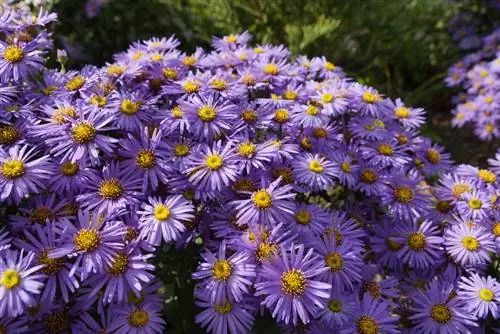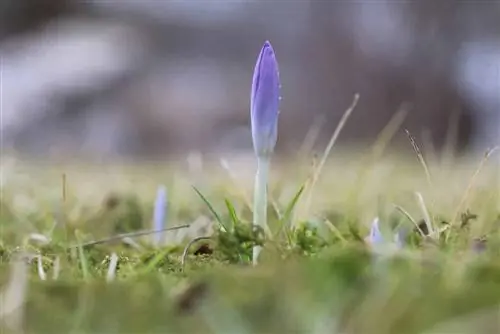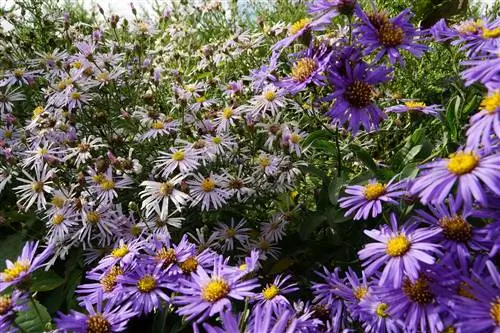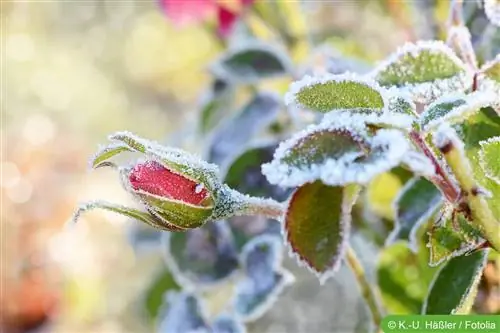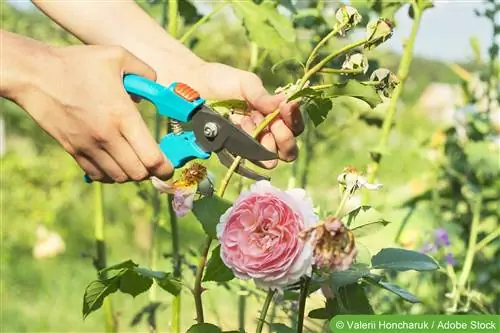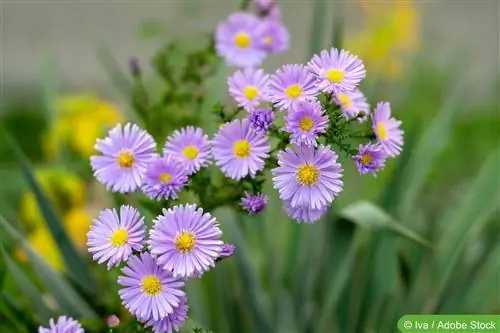- Author admin [email protected].
- Public 2023-12-17 03:39.
- Last modified 2025-01-24 12:45.
What is that, an autumn aster, a winter aster or even a chrysanthemum? A little clarification of terms for more clarity in advance: the winter aster belongs to the Asteraceae family. Botanically they are described as Dendranthema x grandiflorum or Chrysanthemum indicum hybrids. The winter aster moved into our gardens from East Asia. Other names include garden chrysanthemum, farmer's chrysanthemum or autumn aster. The latter, however, strictly speaking belongs to the genus Aster sp., which originates in North America.
Location and soil
Winter asters are an enrichment for every perennial bed. When most flowering plants have already formed their seeds and dried out, they are at their best. Some varieties bloom into December. When choosing a location, however, it must be ensured that they get enough sun or at least brightness as the days become shorter. In winter, constantly wet areas of soil are unsuitable for winter asters. They also look good in pots. The sunnier the location, the greater the flowering potential. The soil should be loose and nutrient-rich. Compacted soil should be thoroughly loosened and mixed with sand before placement. Mixing with compost ensures sufficient nutrients in the long term. Soils that tend to retain a lot of moisture in winter are unfavorable. Rot occurs, especially in the areas of new shoots.
Watering and fertilizing
The water requirements of winter asters are quite high, especially in summer. However, they don't appreciate splashing water from above at all. In pots, it is best to water them from below or submerge them. Constant wetness on their leaves leads to increased susceptibility to powdery mildew. In the bed, the chrysanthemums are best watered heavily from below. A constant sprinkling of water by an or similar. is therefore to be avoided. The flowering in late summer and autumn also depends on the watering in summer. Basically, the asters in pots need more regular watering than the specimens planted outdoors. During the rest period in winter, the winter aster only needs enough water to ensure that its root ball does not dry out completely. The winter asters love it to be rich in nutrients. Once a year, before flowering in summer, or twice a year, in spring and autumn, seasoned manure or compost is added to the bed. This is how strong, he althy clumps develop. Instead, an inorganic fertilizer for flowering plants with a higher phosphorus content can be applied as directed.
Tip:
If the leaves and flowers become slightly droopy, water them as soon as possible. However, you shouldn't let it get to these signs too often, neither in the pot nor outdoors. Too frequent lack of water has a negative effect on flowering.
Cutting
During the flowering period, regular thinning out of faded flowers ensures many new flowers. After flowering, the winter asters can then be cut back close to the ground. If the cut is only done in spring, the plant is better protected from frost by the foliage. Spring pruning is particularly recommended for young specimens and varieties that are more sensitive to frost. In spring you can trim the new shoots to promote denser branching.
Wintering

Winter-hardy chrysanthemums in pots are placed in a protected location and, if necessary, wrapped with fleece. Most varieties do not require much winter protection in the bed. Young plants and more sensitive varieties can be covered with leaves or brushwood. The degree of winter hardiness varies considerably from variety to variety. Depending on the region and location, chrysanthemums may not survive a winter, even though specialist retailers have advertised them as hardy. Due to the low sales price of most varieties, the bare spots can then be replaced with new plants in the spring.
Propagate
As a rule, all types of winter or autumn asters can be propagated without any problems:
Division
You should divide the perennial cushions every three years. The best time for this is spring. If this thinning does not take place, the flower heads will become smaller and smaller over the years. To divide, carefully dig up the plant and divide the root ball with a sharp knife. The parts are then reinserted at the desired locations.
Cuttings
To do this, shoot tips up to 10 cm long are cut off in spring and placed in a mixture of soil and sand. This should now be kept constantly moist at temperatures around 18°C. After rooting, cut off the young shoots more often to encourage multiple branching.
Tip:
If you want to propagate your winter asters from cuttings in spring, you should not cut them off close to the ground everywhere after they have bloomed. The shoots that are best suited for cuttings in spring form from the side buds.
Sowing
In early spring you can put the aster seeds directly into the bed. The seeds of winter asters can be grown all year round in small pots with growing soil in the greenhouse or winter garden (at 18° C - 20° C).
Plants
You can usually buy winter chrysanthemums as container plants. They can then be placed outdoors at any time of the year. However, the best time is always spring. The plant will then have enough time to establish itself properly until next winter. Spring is also the best time to repot potted asters.
Diseases and pests
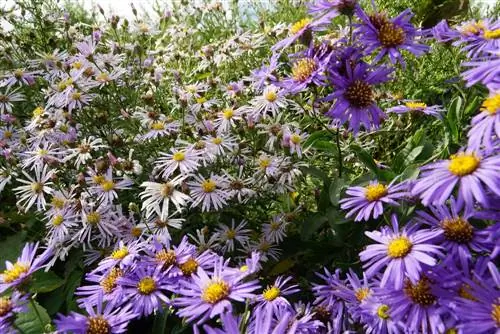
Very good news in advance, snails don't like chrysanthemums and asters at all. In general, the susceptibility to pests is limited. Spider mites appear when the winter aster in the pot is too dark and warm in its winter quarters. If there is a lot of moisture from above, gray mold and mildew can occur in both pot and outdoor cultivation. In this case, the affected shoots must be removed. A tea extract made from field horsetail is, in addition to the right location and proper care, a good precautionary measure. Another fungal disease is aster wilt. If immediate watering does not improve the hanging leaves, it is most likely aster wilt. There is a special plant protection product available from specialist retailers.
Species
The perennial autumn chrysanthemums (winter asters) are available in small pots from specialist retailers. They seem quite inconspicuous in contrast to the annual, spherical, lushly flowering farmer's chrysanthemums. But in the open field they also reach their peak performance quite quickly and develop strong flowers. The flowering of the autumn aster (aka winter aster, farmer's chrysanthemum) usually only begins after the actual autumn aster (Aster sp.) has flowered. Particularly beautiful and robust varieties:
The plants from the Indicum hybrid group usually produce double flowers with a spicy chrysanthemum scent:
- 'November Sun' yellow flowering
- ‘Vreneli’ copper-red flowering
The Koreanum hybrid varieties are particularly hardy:
- 'Isabellarosa' single flowers, beige pink
- ‘Linnocence’ delicate pink flowers
The Rubellum hybrids have strikingly cut foliage and are very vigorous and hardy:
- ‘Duchess of Edinburgh’ red flowering
- ‘Clara Curtis’ pink-violet flowering
Another collecting group are the Hortorum hybrids:
- 'Schwalbenstolz' blooms dark brown
- ‘White Bouquet’ double flowers, white
Conclusion
With just a few care measures in terms of water, fertilizer and pruning, the hardy varieties of winter asters (chrysanthemums) and autumn asters ensure a good mood in the autumnal bed. As cut flowers they last a long time in the vase. Many insects and butterflies also enjoy the late flowers in the autumn sun.

